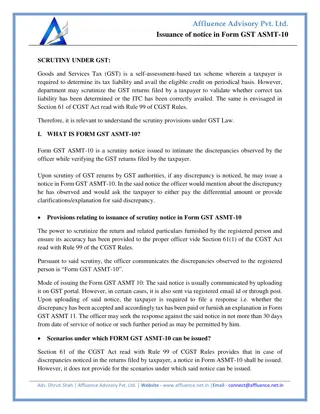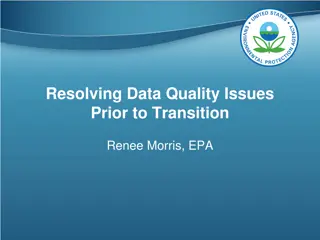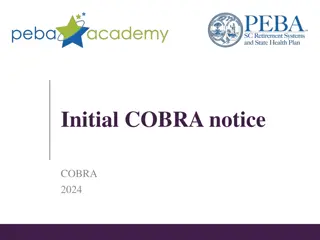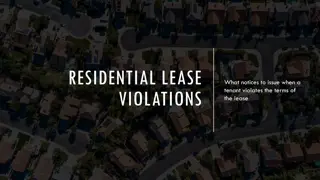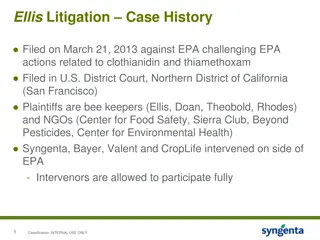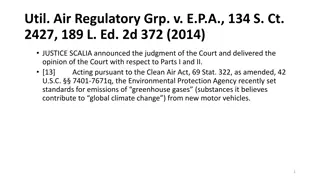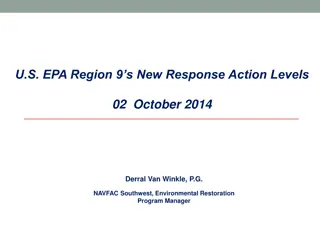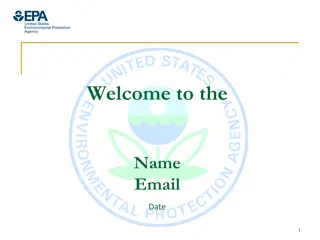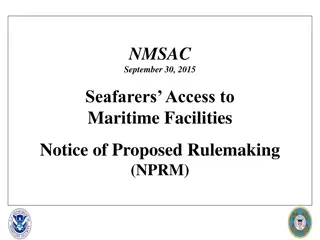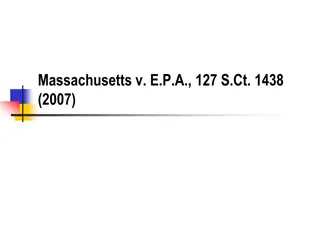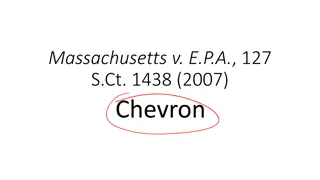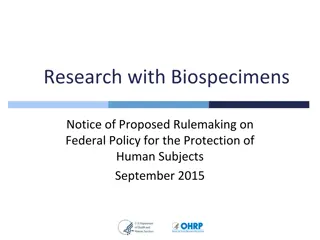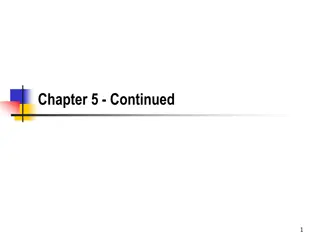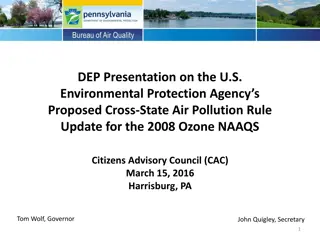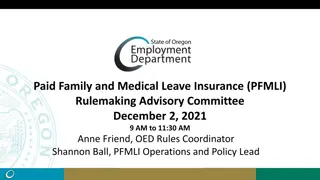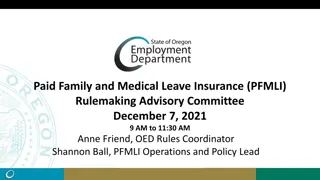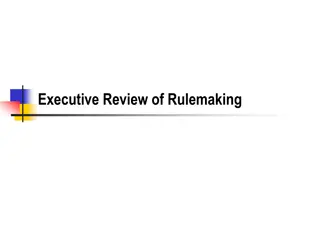EPA Advance Notice of Proposed Rulemaking on Used Drum Management
The Environmental Protection Agency (EPA) has issued an Advance Notice of Proposed Rulemaking regarding the management of used industrial containers, specifically focusing on drum reconditioning. The ANPR seeks input on both non-regulatory and regulatory options to ensure the proper handling of containers that previously held hazardous chemicals or waste. The proposed rule addresses concerns about the volume of containers processed by reconditioning facilities and potential revisions to existing regulations.
Download Presentation

Please find below an Image/Link to download the presentation.
The content on the website is provided AS IS for your information and personal use only. It may not be sold, licensed, or shared on other websites without obtaining consent from the author. Download presentation by click this link. If you encounter any issues during the download, it is possible that the publisher has removed the file from their server.
E N D
Presentation Transcript
Solid and Hazardous Waste/Recycling Administrative/Judicial Developments: 2023 2024 1
Walter G. Wright Mitchell, Williams, Selig, Gates & Woodyard 501-688-8839 wwright@mwlaw.com 2
Discussion will address: A variety of federal and state decisions, litigation, rulings, regulations, policies, etc., either directly or indirectly related to solid or hazardous waste (including recycling) that have arisen over the last 12 months or so. 3
Source of information that often addresses issues relevant to solid/hazardous waste and recycling issues: Arkansas Environmental, Energy and Water Law Blog http://www.mitchellwilliamslaw.com/blog Three posts five days a week 4
Reconditioning/Used Drum Management: Addressing U.S. Environmental Protection Agency Advance Notice of Proposed Rulemaking EPA issued an Advance Notice of Proposed Rulemaking titled: Used Drum Management Reconditioning 88 Fed. Reg. 54537 (Aug. 11, 2023) EPA s ANPR solicits information/requests comments to assist the Federal Agency in the potential development of: non-regulatory and regulatory options that would ensure the proper management if used industrial containers that held hazardous chemicals or hazardous waste, up to and including the drum reconditioning process. Drum reconditioning facilities clean and recondition metal and plastic type intermediate bulk containers for resale and re-use by cleaning, restoring, testing, and certifying the industrial containers. The containers may have held substances such as chemicals, resins, tars, adhesives, oils, soaps, solids, and related materials. 5
Reconditioning/Used Drum Management: Addressing U.S. Environmental Protection Agency Advance Notice of Proposed Rulemaking EPA has described the two main processes used for reconditioning as: Burning residuals for metal drums in a burn-oven or furnace Washing metal or plastic drums with water and/or a caustic solution to remove residues. A RCRA provision is relevant to drum reconditioning. The so-called emptycontainer provision exempts RCRA hazardous waster residues remaining in the drum or other container if certain conditions are met. See 40 C.F.R. 261.7. EPA s concern is that the volume of containers handled by reconditioning facilities could result in some non-RCRA empty containers being accepted. EPA describes the potential options for revising its regulation of drum reconditioning as: Revising the RCRA regulations Non-regulatory options 6
Reconditioning/Used Drum Management: Addressing U.S. Environmental Protection Agency Advance Notice of Proposed Rulemaking Some concerns have been expressed: Potential unintended consequences on the existence compliance framework within which permitted treatment storage and disposal facilities successfully operate Basis on which EPA is considering potential changes is flawed/outdated EPA resources would be better used on education/compliance assistance efforts to improve implementation of existing standards Existing standards when complied with are both effective and protective of human health in the environment The changes to the RCRA empty standards being contemplated by EPA will not improve the management of used containers and will add unnecessary burden to container generators, particulary those already permitted treatment storage and disposal facilities, and reconditioners 7
Non-Hazardous Secondary Material Standards: U.S. Environmental Protection Agency Final Response to American Forest and Paper Association Petition EPA published in October 18th Federal Register a final response to an American Forest and Paper Association Petition to revise the National Hazardous Secondary Materials regulations. See 88 Fed. Reg. 71761. EPA is: Denying the requested revisions in the AFPA Petition Revising the definition of paper recycling residuals to limit the impact non-fiber materials may have on the heat value of paper recycling residuals in order for them to be considered a non-waste fuel Section 129(a)(1)(D) of the clean Air Act requires that EPA establish standards for commercial and industrial solid waster incinerators which burn solid waste. The term solid waste was defined by Section 129(g)(6) of the Clean Air Act to provide that the term solid waste is established by EPA under RCRA. 8
Non-Hazardous Secondary Material Standards: U.S. Environmental Protection Agency Final Response to American Forest and Paper Association Petition The NHSM regulations provide the standards and procedures for identifying when non- hazardous secondary materials burned in combustion units constitute solid waste. AFPA s petition requested certain amendments to the NHSM regulations which include: Change mandatory to shouldconsider a legitimacy criterion for comparison of contaminants in the NHSM to the traditional fuel the unit is designed to burn found at 40 C.F.R. 241.3(d)(1)(iii). Remove associated design to burn and other limitations for creosote-treated railroad ties found at C.F.R. 241.4(a)(7)-(A)(10). Revise the definition of paper recycling residuals that can be burned as non- waste found at 40 C.F.R. 241.2 to remove the limit on non-fiber materials. 9
RCRA Corrosivity Hazardous Waste Characteristic: Federal Appellate Court Addresses Denial of Petition Requesting Expansion The United States Court of Appeals for the District of Columbia addressed in a July 25th decision an issue involving the RCRA hazardous waste characteristic of corrosivity. See Public Employees for Environmental Responsibility v. Environmental Protection Agency, 2023 WL 4714021. The question addressed was whether the EPA properly declined to revise its definition of corrosive. The Public Employees for Environmental Responsibility submitted a petition in 2011 seeking two changes which include: 1. Revision of pH regulatory value for defining a waste as corrosive hazardous waste from the current pH 12.5 or higher, to pH 11.5 or higher; and 2. Expansion of the scope of the corrosivity regulation to apply to non-aqueous waste in addition to the aqueous waste addressed by the current regulation EPA denied PEER s petition for rulemaking and determined that changes to the corrosivity characteristic regulation were not supported by available information. The Court upheld EPA s decision 10
Variance from Classification as RCRA Solid Waste: U.S. Environmental Protection Agency Grants Tucson, Arizona, Facility Petition EPA in a July 5th Federal Register Notice granted a petition for variances from the classification as RCRA solid waste for HVF Precious Metals, LLC. 40 C.F.R. 260.30(c) provides the EPA Administrator the ability to determine on a case-by-case basis that materials that have been reclaimed but must be further reclaimed before the materials are fully recovered are not solid wastes. The HVF petition described two partially-reclaimed materials described as SolutionSweeps and FilterSweeps. Such materials are stated to be produced at HVF s Tucson, Arizona, facility from precious metal- bearing waste from cyanide-based electroplating operations. EPA states it determined that the two materials are commodity-like under the criteria listed in 40 C.F.R. 260.31(c). 11
Lithium Battery Recycling Regulatory Status: US Environmental Protection Agency Issues Memorandum Addressing Frequently Asked Questions EPA issued a May 24th Guidance Memorandum titled: Lithium Battery Recycling Regulatory Status and Frequently Asked Questions The stated purpose of the Memorandum is to clarify how the hazardous waste regulations for universal waste and recycling apply to lithium-ion batteries. 12
Solar Panels/Lithium Batteries/RCRA: U.S. Environmental Protection Agency Announces Plan to Craft/Modify Universal Waste Regulations EPA announced that it is planning to propose new rules universally to improve the management and recycling of end-of-life solar panels and lithium batteries. EPA states it is considering proposing: Adding hazardous waste solar panels to the RCRA universal waste regulations. Establishing a new/distinct category of universal waste specifically tailored to lithium batteries. Because of the explosion of clean energy infrastructure in projects, EPA focused attention on the disposition of these two clean energy components at end-of-life. 13
Solar Panels/Lithium Batteries/RCRA: U.S. Environmental Protection Agency Announces Plan to Craft/Modify Universal Waste Regulations EPA indicated that hazardous waste testing of solar panels has determined that different varieties may have varied metals present in the semiconductor and solder. Metals such as lead and cadmium are projected to be present in some circumstances such that they could be considered characteristic RCRA hazardous waste (but may vary). Similar concerns apply to lithium batteries because of their use in electric vehicles. Lithium-ion batteries are already typically deemed RCRA hazardous waste (and are designated as universal waste). EPA s concern is that the possibility for fires when improperly managed represents a risk that needs to be addressed by modified universal waste regulations. 14
Toxic Release Inventory/Community Right-to-Know: U.S. Environmental Protection Agency Releases Annual National Report United States Environmental Protection Agency released its Annual Toxics Release Inventory National Analysis. TRI is a publicly available database prepared and published by EPA annually pursuant to the Federal Emergency Planning and Community Right-to-Know Act which was enacted 1986. TRI contains information on the release of several hundred chemicals and chemical categories from industries including manufacturing, metal and coal mining, electric utilities, and commercial hazardous waste treatment (among others).
Toxic Release Inventory/Community Right-to-Know: U.S. Environmental Protection Agency Releases Annual National Report The Analysis indicates: Toxic chemical releases have declined 21% in ten years. Releases in the ten-year period from manufacturing facilities decreased by 9%. A 6.5% in the number of pollution prevention activities was reported to have occurred from 2021-2022. Facilities reported managing 88.5% of their TRI chemical waste through what are described as Preferred Practices such as recycling, energy recovery, and treatment in 2022. 21,000 facilities submitted reports on 522 of the 827 chemicals in categories for which TRI reporting is required. Facilities implemented 3,589 total pollution prevention activities in 2022, with the most common including: Process and equipment modifications. Changes to operating practices and training.
Lead Contaminated Soil/Residential Sites: U.S. Environmental Protection Agency Lowers Recommended Screening Levels EPA announced that it is lowering recommended screening levels for assessing and remediating lead-contaminated soil in residential areas. The recommended screening levels for lead-contaminated soil in residential areas are lowered to 200 parts per million and 100 ppm when additional sources of lead are identified. This is the first time in 30 years that EPA has lowered the screening levels for lead-contaminated soil. Relevant to RCRA and CERCLA corrective action/remediation. 17
Lead Contaminated Soil/Residential Sites: U.S. Environmental Protection Agency Lowers Recommended Screening Levels EPA typically describes soil screening levels as a guidance tool whose purpose is to standardize and accelerate the evaluation and cleanup of contaminated soils. Screening levels guidance are not generally national cleanup standards. They do not alone necessarily trigger the need for responsive actions or define unacceptable levels of contaminants in soil. Screening often refers to the process of identifying and defining areas, contaminants, and conditions at a site that do not require further attention. 18
Lead-Sheathed Telecom/Power Cables: Environmental Defense Fund Request to U.S. Environmental Protection Agency The Environmental Defense Fund sent a July 17th letter to the EPA Administrator addressing what it described as lead-sheathed telecom and power cables. EDF requested that EPA investigate: The uncontrolled release of lead into the water or surface soil from more than 2,000 lead- sheathed telecom and power cables across the nation with more than 300 of these cables posing a threat to the source of drinking water for communities. EDF asserts that due to the absence of EPA intervention: Risks posed by the cables will increase as they further deteriorate Lead will be released into the environment The letter requests that EPA use Comprehensive Environmental Response, Compensation and Liability Act authority and Safe Drinking Water Act response authorities to address the issue. 19
PFAS/CERCLA (Superfund) Liability: U.S. Senator John Boozman (Arkansas) Legislation Exempting Noncontributing Industries/Municipalities United States Senators John Boozman (Arkansas) and Cynthia Lummis (Wyoming) introduced five bills to ensure industries and municipalities are not subject to Comprehensive Environmental Response, Compensation, and Liability Act liability if EPA designates PFAS compounds as hazardous substances. The rationale for exempting such entities is that they either: Do not contribute to PFAS contamination; or Are required to use PFAS-containing substances through regulations Designation of PFAS as a CERCLA hazardous substance would trigger corresponding requirements such as: Application of the potentially responsible liability categories (i.e., current owner or operator, former owner or operator [in certain circumstances], transporter [in certain circumstances], and generators). Hazardous substance release reporting requirements (if reportable quantities are released) 20
PFAS/CERCLA (Superfund) Liability: U.S. Senator John Boozman (Arkansas) Legislation Exempting Noncontributing Industries/Municipalities The Five bills are: Agriculture PFAS Liability Protection Act Airports PFAS Liability Protection Act Fire Suppression PFAs Liability Protection Act Resource Management PFAS Liability Protection Act (Landfills/Composting) Water Systems PFAS Liability Protection Act 21
U.S. Environmental Protection Agency Information Collection Request: POTW Influent PFAS Study Data United State Environmental Protection Agency published a notice in the March 26th Federal Register that it is planning to submit an information collection request titled: U.S. Environmental Protection Agency POTW Influent PFAS Study Data Collection. The information request objective is stated to include obtaining data from Publicly Owned Treatment Works addressing: PFAS discharges from upstream industrial facilities. Presence of PFAS in POTW influent, effluent, and sewage sludge.
PFAS/Clean Water Act Enforcement: Michigan Attorney General Files Action Against Grand Rapids Airport for Alleged Contamination Michigan Attorney General filed a September 11th lawsuit in the Kent County 17th Judicial Circuit against the Gerald R. Ford International Airport Authority in Grand Rapids, Michigan The Alleged basis for the lawsuit is stated to involve: PFAS releases into the below-ground water supply 23
PFAS/Clean Water Act Enforcement: Michigan Attorney General Files Action Against Grand Rapids Airport for Alleged Contamination Of relevance here is their use in firefighting at airports The AG s news release states that the lawsuit contends the Airport Authority is liable for its previous and known releases of the PFAS- containing firefighting material known as aqueous film-forming foams pursuant to: Part 201 (Environmental Remediation) of the Michigan Natural Resources and Environmental Protection Act Violations of its National pollutant Discharge Elimination System Permit The Alleged PFAS releases are stated to have impacted nearby properties and been discovered in residential drinking water wells in Cascade Charter Township, as well as in streams and other groundwater downgradient of the Airport 24
Recycling Defense/CERCLA: U.S. District Court Addresses Applicability of Superfund Recycling Equity Act A United States District Court addressed in an Order an issue arising under the federal Comprehensive Environmental Response, Compensation, and Liability Act. See California Department of Toxic Substances Control et al. v. NL Industries, Inc., et al., Case No. 2:20-cv-11293-SVW-JPR. The question addressed was whether two companies that sent either spent lead- acid batteries or battery tops to a Superfund site were exempt from CERCLA arranger liability because of the recycling defense provided by the Superfund Recycling Equity Act. A number of states, such as Arkansas, have adopted a similar exemption to their analogous Superfund statutes. 25
Recycling Defense/CERCLA: U.S. District Court Addresses Applicability of Superfund Recycling Equity Act The Court in its Order found that: Ekco and Quemetco were differently situated from the other defendants because the Court found that all they sent to the Plant were spent lead-acid batteries. The Court found that they met their burden in meeting SREA s requirements and that Plaintiffs did not meet their burden in showing an exception to the SREA exemption applied. Therefore, these defendants had a complete defense to CERCLA and HSAA liability. As to the battery tops, the Court stated that: . . . those were useful products as to Ekco. In the alternative, they were scrap metal and qualified for SREA protection. In any event, the Court found persuasive that Ekco did not break the batteries themselves to obtain those tops and instead that the tops would have been sent by Ekco scustomers. 26
Oil Pollution Act - Oil/CERCLA - Hazardous Substance: Federal Appellate Court Addresses Which Statute Governs When the Substances are Mixed and Released The United States Court of Appeals for the Fifth Circuit addressed in an October 27th Opinion an issue arising out of the Oil Pollution Act of 1990 and Comprehensive Environmental Response, Compensation, and Lability Act. MUNOZ v. Intercontinental Terminals, L.L.C. No. 22-20456. The question addressed was which statute governs when OPA oil mixed with CERCLA hazardous substances are released. Intercontinental Terminals Company operates a chemical-storage facility in Deerpark, Texas. A fire occurred in 2019. In an effort to exert control, various tank products, firewater, and firefighting foam were placed and accumulated in ITC s secondary containment area. 27
Oil Pollution Act - Oil/CERCLA - Hazardous Substance: Federal Appellate Court Addresses Which Statute Governs When the Substances are Mixed and Released The government agencies involved in the spill clean-up determined that of the 50 chemicals released: 17 constitute CERCLA hazardous substances Five constitute OPA oils Subsequent sampling determined that the spill consisted of oil mixed with hazardous substances. Therefore, the United States Environmental Protection Agency and Coast Guard determined that the spill was a CERCLA incident. Texas Aromatics argued that both CERCLA and OPA can apply to a mixed spill of oil and CERCLA hazardous substances. The 5th Circuit Appellate Court upholds the United States District Court s interpretation that OPA s definition of oil excludes a comingled mixture of oil and CERCLA hazardous substances. 28
CERCLA Cost Recovery: Federal Court Addresses Whether Municipalitys Urban Renewal activities Potentially Constitute Arranger Liability A United States District Court addressed in an October 13th Order an issue arising out of a Comprehensive Environmental Response, Compensation and Liability Act cost recovery action. See Banfield Realty LLC v. William E. Copeland, et al., 2023 WL 6796216. The CERCLA question involved whether a city and housing authority s activities potentially fell within the scope of the arranger for treatment of disposal liability ( potentially responsible party ) category. Banfield Realty, LLC purchased property in Portsmouth, New Hampshire. Significant environmental contamination was discovered shortly after purchase. The property was purchased from the Copelands and an entity. The Copelands are alleged to have used the property for various uses such as: Solid waste landfill Automobile repair shop Car crushing facility Salvage Yard 29
CERCLA Cost Recovery: Federal Court Addresses Whether Municipalitys Urban Renewal activities Potentially Constitute Arranger Liability Banfield discovered that the property was contaminated from multiple sources and releases over the past several decades. Those sources were alleged by Banfield to include the City of Portsmouth and the Portsmouth Housing Authority. Cited by Banfield was a New Hampshire Department of Environmental Services landfill registration form in which it was reported that during the 1960s: Building and construction waste was disposed of on the site, as part of the City of Portsmouth s urban renewal. Banfield further alleged that both the City of Portsmouth and the PHA were involved in the City s urban development. This was premised on the fact that the PHA was created in 1953 and many of its early projects are stated to have involved the urban renewal of Portsmouth. The Court agreed that the references to the Copeland registration form was meager proof that the urban renewal activities constituted contracting, agreeing, or arranging for the disposal of hazardous substances involving construction materials. 30
CERCLA Cost Recovery: Federal Court Addresses Whether Municipalitys Urban Renewal activities Potentially Constitute Arranger Liability CERCLA liability is stated to attach if an entity enters: Into a transaction for the sole purpose of discarding a used and no longer useful hazardous substance. Therefore, the Court held it was not unreasonable: to infer, based on that allegation, that the waste was dumped in accordance with an agreement between Portsmouth/PHA (or its contractors and the Copelands) Consequently, Banfield was held to have sufficiently but barely adequately alleged that Portsmouth and PHA are liable as arrangers under Section 9607(a)(3). The Motion to Dismiss the CERCLA claim was denied. 31
Fiscal Superfund Revenues Lower than expected tax revenue Chemical and Crude Oil 32
National Enforcement and Compliance Document: U.S. Environmental Protection Agency Announces Initiatives for Years 2024-2027 The United States Environmental Protection Agency announced its National Enforcement and Compliance Initiatives for fiscal years 2024-2027. EPA chooses every four years national initiatives on which to focus resources on what it believes are serious and widespread environmental problems for which federal enforcement can make a difference. The NECIs include for the first time initiatives to emphasize: Methane emissions from landfills Address exposure to PFAS contamination Address industrial parties that significantly contribute to the release of PFAS into the environment Emphasize coal ash: Address on-site landfills Address settling ponds Address other coal plant surface impoundments EPA notes that environmental justice concerns will be a component of these initiatives. 33
Federal/State Environmental Criminal Enforcement Examples Federal prosecution of hazardous waste collection/disposal facility addressing Georgia and North Carolina facilities involved in knowingly storing carbon sulfide in a warehouse. CEC was sentenced after it pleaded guilty to one count of knowingly storing carbon disulfide (a hazardous material) without a permit. The knowing storage of the carbon disulfide in the amount found at the warehouse was in violation of the provisions of RCRA. The integrity of certain drums and totes is stated to have been compromised, resulting in leakage and potential spillage. 34
Federal/State Environmental Criminal Enforcement New Hampshire indictment at construction and debris landfill facility Between March 30, 2020, and March 22, 2023, alleged failure to report to the New Hampshire Department of Environmental Services exceedance of permit capacity for unprocessed construction and demolition debris. On March 22, 2023, March 18, 2022, and March 11, 2021, submission of an annual facility report with alleged false quantities of waste received by the facility and false representation of compliance with permit terms. California felony charges to a company for collecting waste fuel at scrap yards and sold to gasoline stations. Treatment of hazardous waste at an unauthorized facility. Transportation of hazardous waste to an unauthorized facility. 35
Electronic Waste/ New York State Conviction of Companies/ Individuals Alleged illegal processing and disposal of 800 tons of electronic waste in Seneca County Arkansas railroad settlement with EPA Region 6 over alleged illegal storage of hazardous waste violations at a private rail track. Civil Penalty of $910,985.00 36
Release Reporting/CERCLA Enforcement: U.S. Environmental Protection Agency and Tracy, California, Cheese Manufacturing Facility Enter into Consent Agreement EPA and Leprino Foods Company entered into a February 2nd Consent Agreement addressing alleged violations of the Comprehensive Environmental Response, Compensation, and Liability Act. LFC is stated to be the owner of a cheese manufacturing facility located in Tracy, California. Section 103 of CERCLA requires the Facility to immediately notify the National Response Center of any release of hazardous substances in an amount equal to or greater than the reportable quantity for that substance. 37
Release Reporting/CERCLA Enforcement: U.S. Environmental Protection Agency and Tracy, California, Cheese Manufacturing Facility Enter into Consent Agreement In order for a release to be considered reportable under CERCLA, there are three criteria that must be met: Be into the environment Be equal to or exceed the RQ for a particular hazardous substance Occur within a 24-hour period EPA determined during its investigation that LFC notified the NRC 59 minutes after the start of a release of 109 pounds of ammonia from the Facility on March 31, 2021. EPA alleged that LFC failed to notify the NRC immediately upon having knowledge that a RQ of a hazardous substance had been released at its Facility, violating Section 103 of CERCLA. A civil penalty in the amount of $229,707 is assessed. 38
Illegal Dumping/Environmental Justice: U.S. Department of Justice and City of Houston, Texas, Enter into Settlement The United States Department of Justice entered into a Settlement Agreement with the City of Houston, Texas, in response to illegal dumping in Black and Latino neighborhoods. DOJ had opened an July 26th an environmental justice investigation into the City of Houston s operations, policies, and practices related to illegal dumping. DOJ s Civil Rights Division was stated to be examining whether Houston responded to requests from municipal services (including illegal dumping) in a manner that discriminated against Black and Latino Houston residences and in violation of federal civil rights laws. Title VI prohibits entities receiving federal assistance from engaging in activities that subject individuals to discrimination on the basis of race, color, or national origin. 39
Illegal Dumping/Environmental Justice: U.S. Department of Justice and City of Houston, Texas, Enter into Settlement The Settlement Agreement is stated to establish: A three-year period of federal monitoring Daily reporting obligations Enhanced community outreach with impacted neighborhoods (including an engagement with residences with limited English proficiency) Consideration of actions to combat commercial sources of illegal dumping Reduced restrictions for residents seeking to use waste depositories Federal civil rights training program for specified civil employees 40
OSHA Enforcement: Proposed Penalties Addressing National Tank Cleaning Company for Alleged Violations The Occupational Safety and Health Administration issued an October 23rd news release stating that it has cited Trimac Transportation, Inc. for alleged violations. TTI is described in the news release as a national tank cleaning company. The news release provides that two TTI employees are stated to have suffered injuries when exposed to hydrogen sulfide. The gas is stated to have been present during the cleaning process of a tanker truck on April 25th in Beaumont, Texas. Tank cleaning/ confined space is an OSHA enforcement priority 41
OSHA Enforcement: Proposed Penalties Addressing National Tank Cleaning Company for Alleged Violations OSHA alleges that the company: Failed to provide adequate respiratory protection Did not evaluate the worksite for possible respiratory hazards Did not monitor employees for exposure to other substances Failed to provide workers with appropriate respirators Did not conduct respiratory fit testing OSHA proposed penalties of $399,349 42
Medical Waste/Hazardous Waste Enforcement: California Attorney General and California Hospital Organization/Health Plan Enter into Settlement The California Attorney General and six State District Attorneys entered into a Settlement on September 8th with Kaiser Foundation Health Plan, Inc., and Kaiser Foundation Hospitals addressing alleged violations of regulations involving both hazardous waste and medical waste management requirements. The California Attorney General s Office states that the Settlement was the result of undercover inspections conducted by the referenced District Attorneys Offices of dumpsters from 16 different Kaiser facilities. They are stated to have reviewed the contents of unsecured dumpsters destined for disposal for publicly accessible landfills. 43
Medical Waste/Hazardous Waste Enforcement: California Attorney General and California Hospital Organization/Health Plan Enter into Settlement Allegedly discovered were items such as: Hazardous and medical waste (aerosols, cleansers, sanitizers, batteries, electronic wastes, syringes, metal tubing with bodily fluids, and pharmaceuticals) 10,000 paper records containing the information of over 7,700 patients The Settlement requires that Kaiser: Pay a $47,250,000 penalty that includes: An additional $1.75 million in civil penalties if within five years of the entry of the final judgment Kaiser has not spent $30.5 million at its California facilities to implement enhanced environmental compliance measures to ensure compliance with relevant provisions of the law that are alleged to have been violated Retain an independent third-party auditor to conduct 520 trash compactor audits at Kaiser s California facilities. 44
Criminal Enforcement/Beverage Container Recycling Program: California Attorney General Files Felony Complaint Against Eight Individuals for Alleged Fraud The AG alleges that the suspect individuals defrauded California s Beverage Container Recycling Program. The California Redemption Value fee objective is to incentivize recycling at privately-owned centers with a 5- or 10-cent return on eligible beverage containers. Only material from California is eligible for redemption under this program. The Complaint alleges that the individuals smuggled 178 tons of aluminum cans and plastic bottles from Arizona. The felonies charged in the Complaint include: Recycling fraud Grand theft Conspiracy 45
Underground Storage Tank Fund/California State Water Resources Control Board: Los Angeles Environmental Consulting Firm Enters into Settlement Addressing Alleged Inflated Invoices California State Water Resources Control Board and Associated Consulting Civil & Environmental Services, Inc. along with an individual entered into a January 17th document styled: Settlement Agreement and Stipulation for Entry of Administrative Civil Liability Order. Settlement Agreement resolves allegations that Associated Consulting inflated invoices submitted to the Board s Underground Storage Tank Cleanup Fund for remediation work. A number of states (including Arkansas) have UST funds that provide reimbursement for certain investigative and/or corrective action costs related to releases from petroleum USTs. 46
Underground Storage Tank Fund/California State Water Resources Control Board: Los Angeles Environmental Consulting Firm Enters into Settlement Addressing Alleged Inflated Invoices Environmental professionals of various types are often utilized to perform the required work and submit the invoices for reimbursement. Settlement Agreement alleges that Associated Consulting made certain misrepresentations in multiple reimbursement requests to the California UST Fund. Settlement Agreement provides that Associated Consulting and the individual dispute the allegations and admit no wrongdoing. The Settlement Agreement also provides the following: 1.Assessment of $150,000 in penalties. 2. Disqualification of Associated Consulting and the individual from participating in future Board funding programs. 47
Environmental Services Agreement: Federal Court Addresses Limitation of Liability Clause The United States District Court addressed in an April 27th Order issues arising out of an environmental services agreement. See Thiele Kaolin Company v. Environmental Resources Management Southeast, Inc., 2023 WL 3137991. One of the issues addressed was a limitation of liability clause. Thiele Kaolin Company entered into an agreement with Environmental Resources Management Southeast, Inc. ERM was tasked to provide certain environmental due diligence services related to Thiele s potential acquisition of mining sites in Sandersville, GA. Thiele alleged discovery of several instances of actual or potential non-compliance with federal and state environmental laws and regulations after the purchase of the sites. 48
Environmental Services Agreement: Federal Court Addresses Limitation of Liability Clause ERM cited a limitation of liability clause reading: UNLESS OTHERWISE AGREED AND EXPRESSLY SET FORTH IN A PROJECT CONTRACT, IN NO EVENT SHALL ONE PARTY, ITS AFFILIATES AND THEIR RESPECTIVE OFFICERS, DIRECTORS, EMPLOYEES, BE LIABLE TO THE OTHER PARTY AND/OR ANYONE CLAIMING BY, THROUGH OR UNDER IT, INCLUDING WITHOUT LIMITATION INSURERS, FOR ANY LOST, DELAYED OR DIMINISHED PROFITS, REVENUES, BUSINESS OPPORTUNITIES OR PRODUCTION OR FOR ANY INCIDENTAL, SPECIAL, INDIRECT, PUNITIVE, EXEMPLARY, FINANCIAL, CONSEQUENTIAL OR ECONOMIC LOSSES OR DAMAGES OF ANY KIND OR NATURE WHATSOEVER, HOWEVER CAUSED. 49
Environmental Services Agreement: Federal Court Addresses Limitation of Liability Clause The Court denied ERM s interpretation of the limitation of liability provision given that their desired meaning ignored many other relevant sections in the contract including the indemnification, insurance, standard of care, and dispute resolution clauses. The Court also held that ambiguity of certain clauses in the Agreement could not be resolved in the context of a motion to dismiss. ERM unsuccessfully argued that the damages Thiele identified were deminimis in comparison to the scope of the project it was assigned. 50

 undefined
undefined






























